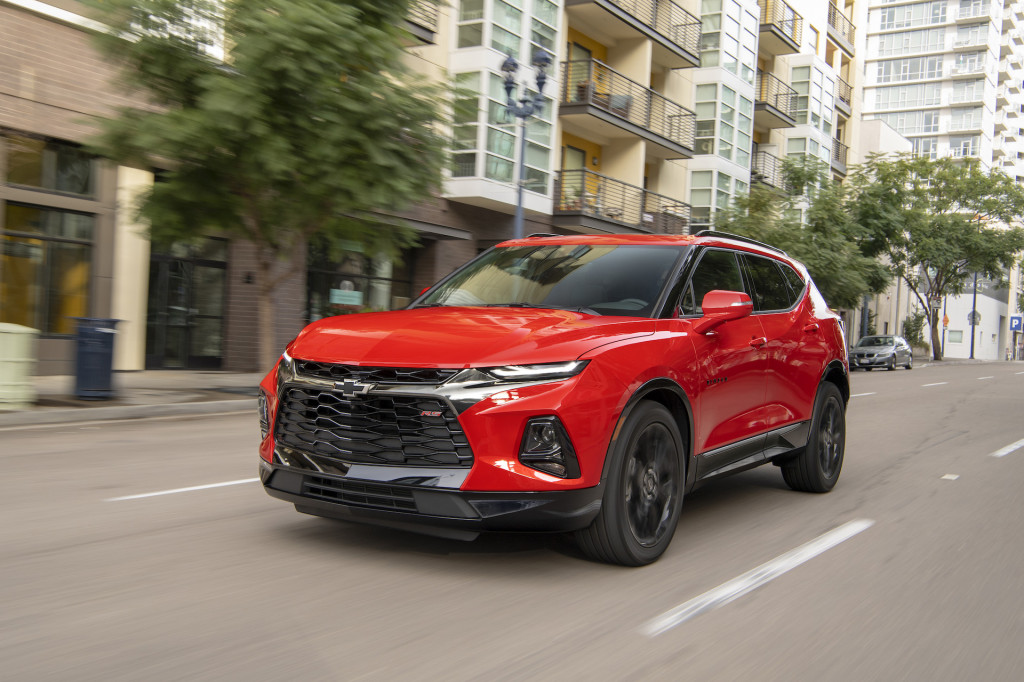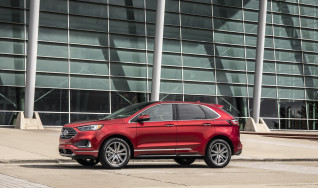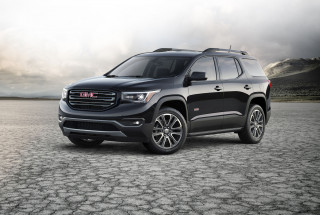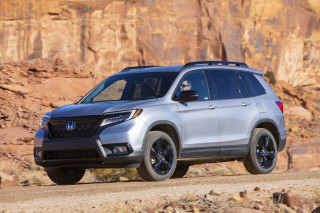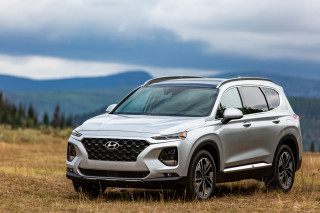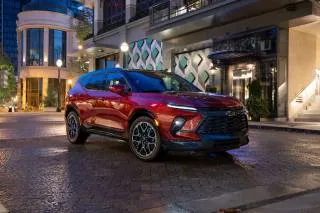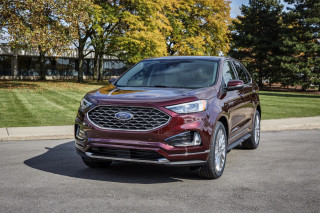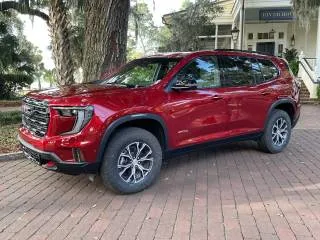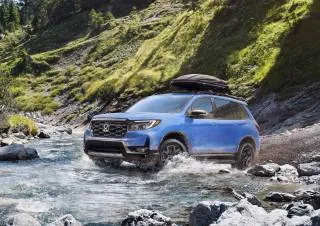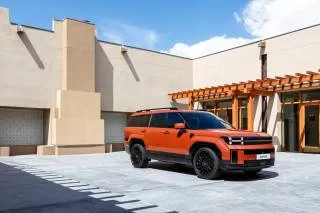Likes
- Clean break from Blazers past
- Towing capacity
- Inline-4 or V-6
Dislikes
- Brand heritage cries foul
- Not substantially bigger than an Equinox
- Will automatic emergency braking be standard?
Buying tip
features & specs
The 2019 Chevrolet Blazer reboots a name from the past, and leaves truck bona fides behind for crossover comfort.
Reboots come in all shapes and sizes, from the kind found on TV and film, to the daily process you go through just to get your phone to receive voice mails.
The 2019 Chevrolet Blazer is a reboot, but the familiar nameplate won't return on a truck-based SUV.
With the reformatted Blazer, Chevy fills the niche in its lineup left between the five-seat Equinox and the seven-seat Traverse. If you're still hoping for a two-door spin-off of the Silverado, we feel your pain, but that Blazer left us a decade ago, and won't be coming back anytime soon.
The new vehicle is a mid-size crossover SUV with front-drive roots, seating for five, and a base inline-4 engine. It's sold in base L, LT, RS, and Premier models.
We give the 2019 Chevy Blazer a 6.2 out of 10, with complete safety scores to come. (Read more about how we rate cars.)
This Blazer looks nothing like the past. It’s divorced its old SUV ball and chain and is swiping right on the crossover look of the moment: Yep, it’s a floating canopy. It works here, though no car works that look like the Nissan Murano does. It plays fine on the longer, higher Blazer bod nonetheless. The cabin’s winglike styling themes create the oddly shaped buttons GM seems to love, but they work well enough, and don’t disrupt the pared-down appeal of the Blazer’s cabin.
The base Blazer has a 193-horsepower inline-4 with acceptable groove but all the aural charm of an imbalanced box fan. Its 9-speed automatic passes out power fairly, and the front-drive base Blazer has a taut ride with well-sorted steering that feels more Malibu than Equinox.
We’ll still take the V-6, thanks, with its 308-hp output, with the bigger 20-inch (or 21-inch) wheels and tires, and with the trick all-wheel-drive setup on Premier and RS editions. It’s gutsy, makes better noises, rides quite firmly, and has connective steering that swings fluidly through esses–and tracks very well on interstates. In this form the new Blazer can tow more than it weighs: 4,500 versus 4,007 pounds (or more, on plusher trims).
Big interior space greets five adult passengers in the Blazer, and the cargo space flexes with a rear seat that slides on a track; the rear seats fold down to create a flat load floor, too. It’s a great recipe but none of the Blazer’s seats fit us well. Base cloth models have pretty quilted stitching but short bottom cushions, and the second-row Blazer bench suffers the same fate.
No Blazer comes standard with automatic emergency braking; that’s an egregious omission even on inexpensive versions, given that the technology’s standard on a $20,000 Corolla. Blind-spot monitors are widely available, but a surround-view camera system and adaptive cruise control are pay-up prospects, and only offered on top trims. Base Blazers get power features, automatic climate control, Apple CarPlay and Android Auto, and Bluetooth with audio streaming. The most expensive versions—at $43,000 and up—sport wireless smartphone charging, a sunroof, leather upholstery, cooled front seats, and a handsfree power tailgate.
2019 Chevrolet Blazer Styling
The 2019 Blazer stands out with a trim body and a winglike dash.
With its floating canopy, its sculptured sides, and the strong scent of Toyota in its front end, the 2019 Chevy Blazer compiles a contemporary look that’s relieved of all the dowdy found on the smaller Equinox.
We give it a 7 here, with a point above average for the interior and the exterior. (Read more about how we rate cars.)
The new 2019 Blazer has donned a more premium look than the Equinox that it barely outsizes. Like the Nissan Murano and Acura RDX, the Blazer has a swoopy shape with lots of clever lines and catchy details, far removed from its truck roots.
From the front, we get more than a faint whiff of Toyota in the way the Blazer’s LED lighting frames its face, and in the tie-fighter shapes across its nose. From the side even the base Blazer sits high off the ground, a stance that’s accentuated by the big wheels and tires and by the upkick at the rear end. Its fenders swell out in a fashionable way, and blackout trim lets its roof seem to float on its rear pillars. At the back, the 2019 Blazer has Camaro-esque taillights mounted high, which leaves a lot of real estate to mask with stampings and cutlines. It’s the weakest link in an otherwise well-executed look.
Premium versions wear a bit more metallic trim, by the way, while the RS blacks that out and adds fillips of red along with chunky, Transformers-style wheels.
The interior of the new Blazer spreads a winglike shape across the dash, and makes some unusual but functional concessions to make it all work. It’s simple in execution without looking plain, from its 8.0-inch touchscreen to the symmetric banks of buttons on the center stack.
The give-and-take of controls takes a second to understand. Chevy puts the USB ports due north of the Blazer’s console smartphone bin—a win—but stitches the climate controls across the dash in a thin band of black buttons. Fan controls? They’re stacked in the middle, above big gimballed vents that put their trim rings to work as temperature-adjustment controls. The vent placement just doesn’t work–air hits hands and eyes almost from every position—but it looks great, though we’re mixed on the SEMA-red trim in the RS model. The big panels of painted plastic on the console look inexpensive, but better than the black-gloss plastic they could be.
2019 Chevrolet Blazer Performance
V-6 muscle and a smart 9-speed keep the 2019 Blazer in good spirits; the ride’s pretty firm.
Chevy tunes its latest Blazer with a distinct edge. It’s far from a wallowy SUV with a pillowy ride and a mute powertrain: The new Blazer’s raspy exhaust, snappy V-6 acceleration and its exceedingly firm ride stretch its family-crossover stance in mostly the right ways.
We think it’s worth a 7, but you’ll want to be choosy with the wheel-and-tire combos. (Read more about how we rate cars.)
The base 2019 Blazer delivers on its low base price with decent acceleration and a taut ride. The 2.5-liter inline-4 churns out 193 hp and 188 lb-ft of torque, both at the top end of the powerband. Acceleration doesn’t feel sluggish, despite a curb weight that starts (!) at 4,007 pounds, thanks to a well-programmed 9-speed automatic that reserves a couple of low gears for launches, then spreads out the middle gears for moderately paced city driving. Push hard and the 4-cylinder builds up a racket like a box fan with a wobble in its hub—despite active noise cancellation on board.
The far more capable Blazer powertrain pairs a burbly 3.6-liter V-6 with 308 hp and 270 lb-ft of torque, also coupled to a 9-speed automatic—with no shift paddles, but with a good sense of where it needs to be, and the smarts to get there on time. It’s not quiet either, but save for some direct-injection clatter, the V-6 engine doles out more scrabble than sound; it’s on the right side of history. Drivers can twist a knob on any Blazer to quicken steering and shift points and throttle.
Two flavors of all-wheel drive live on the Blazer order sheet. A basic setup on base models can disconnect power that would otherwise go to the rear wheels, and save some fuel in the process. Drivers will have to remember to put the system back into all-wheel-drive mode, however. The Blazer RS and Blazer Premier trims get a more sophisticated AWD system with a twin-clutch rear differential, which can shift torque between rear wheels, for better handling and for better traction. In addition to the AWD mode, there’s a Sport mode, an Off-Road mode, and a Tow/Haul mode. V-6 Blazers can tow up to 4,500 pounds; 4-cylinders manage just 1,500 lb.
Blazer ride and handling
No matter which Blazer ends up in your driveway, an assertively firm ride and crisp handling will serve as a constant reminder that this car bears almost no relation to the old truck-based Blazers of the past. Things only get more optimistic from there.
All Blazers ride on an independent suspension, have electric power steering, and come fitted with at least 18-inch 235/65 wheels and tires. Base 4-cylinder, front-drive Blazers with the small treads handle small road blemishes with some fidgeting and firmness; take the same surface at a higher speed and the Blazer gets more relaxed. Meanwhile, the steering seems to have two modes: parking lot and bar fight. As speeds rise, it gets heavy and not informatively so, but tracks well on the highway thanks to lots of programmed-in centering force.
On the Blazer Premier and Blazer RS, the wheels get bigger—20-inchers come standard, with 21s an option—but the ride gets slightly better. The Blazer’s great on smooth pavement regardless, but Premier and RS models seem more absorbent despite 265/45 treads–and despite stiffer struts and shocks on the RS (40 percent stiffer in front, but 15 percent stiffer at the back; the RS also gets mildly quicker steering).
Spin the RS Blazer into sport drive mode, and the clever AWD system engages its twin clutches to manage power across its rear wheels. That in turn gives the Blazer the road manners of a well-tuned modern family sedan, not an SUV. It’s really easy to drive smoothly, as the gearbox lingers in the useful middle gears, as the steering centers itself without stopping at a dozen discrete points along the way. Despite the initial low-speed ride stiffness, the Blazer doesn’t drive like it needs to relax.
2019 Chevrolet Blazer Comfort & Quality
The spacious 2019 Blazer could use more shapely seats.
Chevy sketches out plenty of passenger and cargo space inside the 2019 Blazer, and its sliding second-row seat notches one in the bonus column. If the Blazer’s seats were more shapely and more comfortable, its rating of 7 would easily climb a point, maybe two. (Read more about how we rate cars.)
With seats for five passengers, the Blazer takes sides with the Equinox, and leaves three-row seating to the Traverse and Suburban.
In front, base seats have 6- and 4-way manual adjustment and cloth upholstery. On upper trims, power 8-way seats in front can be heated and cooled and clad in leather. Across the lineup, the Blazer’s seats offered lots of backrest support, but the bottom cushions proved too short and too firm for long-distance comfort. No matter whether they came in quilted cloth, sporty neoprene-like fabric, or leather, the front seats lacked the gentle support of the seats in, say, the Hyundai Santa Fe. Adjustment range is good, so most drivers will find a good seating position, but typical for GM, the Blazer’s steering column does not telescope enough for tall drivers.
The Blazer's rear bench slides to flex cargo and passenger space. Head room is fine, leg room is excellent—particularly since the front seatbacks have been trimmed to produce an extra inch or two of knee room. The raw space available to three adult passengers would come off better were the seats more supportive. The seatbacks recline, and kick forward a bit of lumbar support when they do, but the bottom cushions just aren’t long enough. Chevy fits some trims with heated rear seats.
Chevy counts 64.2 cubic feet of cargo space behind the front seats, and 30.5 cubic feet of space behind the rear seat, which folds perfectly flat. On the nominally smaller Equinox, cargo space totals 63.5 cubic feet, while the much larger Traverse checks in at 98.2 cubic feet. Cargo liftover height is reasonable, and the tailgate can be power-assisted.
Chevy trims the Blazer cabin with interesting shapes, with noticeable swaths of hard grainy plastic on the doors, but a nicely stitched dash cap on some models. All Blazers have active noise cancellation, but 4-cylinder models in particular produce fair amounts of engine and tire whine at lower speeds, and copious exhaust noise, too.
2019 Chevrolet Blazer Safety
The 2019 Blazer hasn’t been crash-tested yet.
Because it’s new, the 2019 Chevy Blazer hasn’t been put through the crash-test regimen at both major rating agencies. Until it’s rated by both agencies, we leave the score here blank. (Read more about how we rate cars.)
Federal testers gave the Blazer a five-star overall score, including five stars in front- and side-crash safety, but four stars for the calculated rollover test.
Every Blazer comes with hill-start assist, and a warning chime that alerts drivers to check the back seat for infants and children in car seats. All-wheel drive is available, but only on LT, RS, and Premier trims, and only with the V-6 engine.
Blazers at the LT trim and above can be fitted with a rear camera mirror, which projects an uninterrupted view from behind the car on the rearview mirror; it’s a setup that takes some acclimation. LT Blazers also can add blind-spot monitors and rear parking sensors.
Only the Blazer RS and Blazer Premier can be fitted with trailer-sway control, adaptive cruise control, active lane control, forward-collision warnings, and automatic emergency braking. Even then, they’re an expensive add-on, an egregious upcharge when the features are standard on base Toyota RAV4 crossovers.
Outward vision in the Blazer is good from most angles, but like most larger crossover SUVs with thick rear roof pillars, that view gets compromised despite the addition of tiny windows near the tailgate. For what it’s worth, the Blazer’s side windows are somewhat short, too, a consequence of the tall-riding crossover body and the lower roofline.
2019 Chevrolet Blazer Features
Chevy omits some vital safety gear from most Blazer trims, but its new infotainment system earns kudos.
The 2019 Chevy Blazer maps out prices and features like its rivals: Edge, Passport, Santa Fe, and Murano. But GM doesn’t make automatic emergency braking part of the deal until prices rise over $40,000, a major oversight. The Blazer’s fine new infotainment interface offsets that somewhat, but the warranty is just average.
We give the 2019 Blazer a 6 for features. (Read more about how we rate cars.)
With the 2019 Blazer, Chevy splits things into four main trim levels. Base $29,995 Blazer L crossovers come with dual-zone automatic climate control; 4 USB ports; an 8.0-inch touchscreen with 6-speaker audio, AM/FM radio, Bluetooth audio streaming, Apple CarPlay and Android Auto compatibility; cruise control; keyless ignition; in-car wireless internet hardware; a 6-way manual driver seat and a 4-way passenger seat; power locks/windows/mirrors; and 18-inch wheels and all-season tires.
All prices include $1,195 in destination charges.
The $33,495 Blazer LT steps things up with satellite radio and a power driver seat. A V-6 engine is a $1,000 option. Some LT models can be fitted with navigation that connects to mapping databases for live updates; other options include Bose audio, blind-spot monitors, rear parking sensors, heated front seats, and a power tailgate.
The $41,795 Blazer RS gets its distinctive look as well as navigation, a cargo-management system, blind-spot monitors, a 120-volt outlet, rear parking sensors, remote start, heated front seats, a power front passenger seat, a heated steering wheel, a power tailgate, and 20-inch wheels. Bose audio is an option, as are heated rear seats, cooled front seats, a rear camera mirror, a sunroof, and 21-inch wheels.
The $43,895 Blazer Premier tops things off with 8-speaker Bose audio, cooled front seats, heated rear seats, and power tilt/telescope steering.
Options range from wireless smartphone charging to memory seats, to a surround-view camera system, to either a rear-seat entertainment system or a pair of tablet holders.
Chevy’s new infotainment interface is pretty, and operates smoothly enough. It offers a sign-in feature that allows drivers to bring settings via the cloud to other properly equipped vehicles. But it also sells a cloud-connected navigation for $10 a month that’s not worth it for any smartphone user. After years of Apple CarPlay and Android Auto usage, we still can’t find a reason to pay more for navigation when phones deliver it in superior fashion. Embedded navigation will become more of a requirement with electric cars—which depend more on it to aid drivers with range anxiety and charging—but for today’s drivers, skipping add-on navigation is one small way to save against the Blazer’s fairly high price.
2019 Chevrolet Blazer Fuel Economy
The Blazer manages combined mileage in the mid-20s.
The 2019 Blazer earns a fuel economy score of 4. (Read more about how we rate cars.)
The EPA says front-drive Blazers with the inline-4 engine earn gas-mileage ratings of 22 mpg city, 27 highway, 24 combined. It pegs the V-6 front-drive Blazer at 20/26/22 mpg. With all-wheel drive, it puts the V-6 Blazer at 18/25/21 mpg.
All Blazers have active grille shutters and stop/start to conserve fuel.
